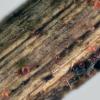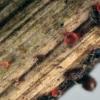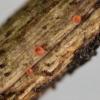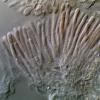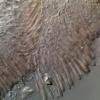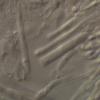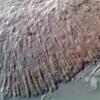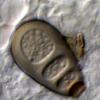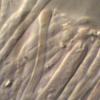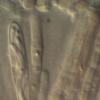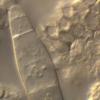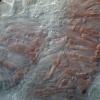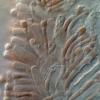
21-12-2025 09:32
Hello.A tiny ascomycete found embedded in wood in

21-12-2025 21:32
Pol DebaenstHello, Garden, Burgweg 19, Veurne, BelgiumOn 10/1

22-12-2025 23:38
Patrice TANCHAUDBonsoir, récolte sur un mur en pierre, apothéci

22-12-2025 00:47
Patrice TANCHAUDBonsoir, récolte à proximité du milieu dunaire

21-12-2025 21:40
Isabelle CharissouBonjour, j'aimerais connaitre les références de

20-12-2025 23:08
Patrice TANCHAUDBonsoir, récolte sur sol sablonneux dans l'arri�
Orbilia on Rubus
Chris Yeates,
18-11-2014 18:37
 Bonsoir tous
Bonsoir tousI have collected a Rubus fruticosus agg. stem. which has a number of rather scattered apothecia of what I take to be an Orbilia. Unfortunately while I have been able to find some asci (distinctly flat-topped) I cannot see anything meaningful within them (this from preparations of two of the most mature apo's). There is an anamophic fungus growing around the apothecia, but it is Endophragmiella boothii (see last image) i.e. anamorphic Melanommataceae (Pleosporales) so not connected. Of considerable interest in one of the mounts is a stray perithecium of what I take to be Wentiomyces sibiricus (but that is another story).
Clearly this means it is impossible to take the Orbilia to species level; however, based on a number of other characters I wonder whether it could at least be taken to a possible section within the genus - it would all add to my stumbling efforts to understand a little more of this fascinating group of ascomycetes.
The characters are:
* The shape of the apothecia, all are more or less bowl-shaped and with a distinct thick margin at all stages of growth, as can be seen from the images.
* The marginal cells which have globose to elliptical pigment held centrally in many of the individual cells; this being pale pink and giving the orange-pink coloration of the apothecia.
* The paraphyses, which are neither capitate nor held together in an epithecium.
* Finally, possibly the habitat? Though I appreciate many Orbilia spp. are not
host-restricted.
Perhaps a a forlorn hope / mince espoir / verlassene Hoffnung - but any thoughts would be welcome
Amitiés
Chris
Uwe Lindemann,
18-11-2014 19:54
Re : Orbilia on Rubus
Due to the pinkish vacuoles in the paraphyses it could be Orbilia rubrovacuolata.
Best, Uwe
Best, Uwe
Hans-Otto Baral,
18-11-2014 20:09

Re : Orbilia on Rubus
Jawohl, Uwe, I have the same opinion. Rubus is not untypical for that species, which is, however, rather plurivoroius.
Chris, can you tell me the collection data? In GB there are no more than two records known to me.
Perhaps you can get the apos ripened?
Chris, can you tell me the collection data? In GB there are no more than two records known to me.
Perhaps you can get the apos ripened?
Chris Yeates,
18-11-2014 20:16

Re : Orbilia on Rubus
Thank you both - I'll sort out the collection details - interestingly (and I'm sure coincidentally ;-) ) Zotto's HB 6588-2 contains a mini-picture of what looks extremely like a conidiophore and conidium of Endophragmiella boothii.
Chris
Chris
Chris Yeates,
18-11-2014 21:07

Re : Orbilia on Rubus
collected
Drop Clough, Marsden area, West Yorkshire
53°36'47.53"N 001°55'10.12"W
(236 metres altitude)
(in fact a few metres from the Micropeziza filicina site!! - I still search, but have never re-found it)
Where is Orbilia rubrovacuolata Baral & Priou published? I see it in MycoBank, but not in Index Fungorum . . . By a very strange coincidence, in between my posting the original thread and receiving Uwe and Zotto's responses I answered an email enquiry from Jean-Paul . . .
I shall try and coax the fungus to produce spores - what is the best way? For many fungi I find that keeping for a short while in the refrigerator (to discourage unwanted mould growth) often works, but Orbilia always seems to dance to a slower tune. I was thinking of putting it in the garden where I can keep an eye on it and where currently it will receive alternate damp and occasional dry weather and it is not very cold yet.
LG
Chris
Drop Clough, Marsden area, West Yorkshire
53°36'47.53"N 001°55'10.12"W
(236 metres altitude)
(in fact a few metres from the Micropeziza filicina site!! - I still search, but have never re-found it)
Where is Orbilia rubrovacuolata Baral & Priou published? I see it in MycoBank, but not in Index Fungorum . . . By a very strange coincidence, in between my posting the original thread and receiving Uwe and Zotto's responses I answered an email enquiry from Jean-Paul . . .
I shall try and coax the fungus to produce spores - what is the best way? For many fungi I find that keeping for a short while in the refrigerator (to discourage unwanted mould growth) often works, but Orbilia always seems to dance to a slower tune. I was thinking of putting it in the garden where I can keep an eye on it and where currently it will receive alternate damp and occasional dry weather and it is not very cold yet.
LG
Chris
Hans-Otto Baral,
18-11-2014 21:48

Re : Orbilia on Rubus
The species is intolerant against drought, at least the asci. The outside temperature is probably the best, but keep it protected from drying by a cover of moss or the like.
We have an idea who put our species on MycoBank, but in fact it is not yet published.
I have seen this Sporidesmiella hyalosperma repeatedly at various occasions, but never knew its name.
Have you a date also for the sample? :-)
Zotto
We have an idea who put our species on MycoBank, but in fact it is not yet published.
I have seen this Sporidesmiella hyalosperma repeatedly at various occasions, but never knew its name.
Have you a date also for the sample? :-)
Zotto
Chris Yeates,
19-11-2014 18:39

Re : Orbilia on Rubus
Saturday 15th November 2014
I made a slip - the hyphomycete in Zotto's drawing and in the image at the top of this thread is Endophragmiella boothii - I should have looked at ASCOFrance ;-)
http://www.ascofrance.com/search_recolte/3063
regards
Chris
I made a slip - the hyphomycete in Zotto's drawing and in the image at the top of this thread is Endophragmiella boothii - I should have looked at ASCOFrance ;-)
http://www.ascofrance.com/search_recolte/3063
regards
Chris
Hans-Otto Baral,
19-11-2014 20:56

Re : Orbilia on Rubus
yes it is, glad to have a name for it! It was too long ago foor you to remember :-)
If you intend to preserve a voucher of this Orbilia, please let me know its number.
If you intend to preserve a voucher of this Orbilia, please let me know its number.
Chris Yeates,
28-11-2014 15:21

Re : Orbilia on Rubus
Success!
In the end I kept the Rubus stem damp (but not wet) in the refrigerator for a couple of weeks. Although mature asci were not frequent, sufficient were, and showed the narrow curved spores of O. rubrovacuolata, with four of them 'reversed' in the ascus.
Also present on the apothecium I examined was a distinctive Dactylella conidium (52.7 x 11.4µm). So all the elements of Zotto's HB 6588-2 here - even the, presumably accidental, Endophragmiella boothii.
amitiés
Chris
In the end I kept the Rubus stem damp (but not wet) in the refrigerator for a couple of weeks. Although mature asci were not frequent, sufficient were, and showed the narrow curved spores of O. rubrovacuolata, with four of them 'reversed' in the ascus.
Also present on the apothecium I examined was a distinctive Dactylella conidium (52.7 x 11.4µm). So all the elements of Zotto's HB 6588-2 here - even the, presumably accidental, Endophragmiella boothii.
amitiés
Chris
Hans-Otto Baral,
28-11-2014 17:46

Re : Orbilia on Rubus
Thanks for this. The conidium belongs to a Dactylellina trapping nematodes by adhesive knobs, but has no special name.
Chris Yeates,
10-10-2015 17:10

Re : Orbilia on Rubus
I would never have believed I could (correctly) recognise an Orbilia in the field! A second Yorkshire (4th UK?) locality for Orbilia rubrovacuolata. Again on Rubus fruticosus and again(!) with Endophragmiella boothii growing with it (see conidium in the image below) - one can only suppose that these unrelated fungi have similar habitat requirements.
collection details:
9th October 2015
collection details:
9th October 2015
on dead twig of Rubus fruticosus agg. (voucher: Hb. CSVY/F/2654)
small area of suburban woodland, Edgerton, Huddersfield, West Yorkshire, UK
53°39'21.67"N
1°48'19.11"W
138 metres altitude
cordialement
Chris
Hans-Otto Baral,
12-10-2015 11:09

Re : Orbilia on Rubus
Hi Chris
splendid! And I did not miss this posting, I took the data in our monograph, and I actually answered, but cannot find my answer anywhere. It is the fifth record in GB.
Zotto
splendid! And I did not miss this posting, I took the data in our monograph, and I actually answered, but cannot find my answer anywhere. It is the fifth record in GB.
Zotto
